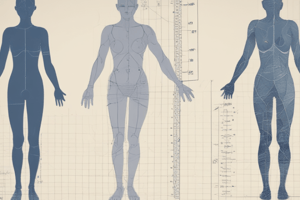Podcast
Questions and Answers
The mean difference between length and stature of a 2-year-old is approximately 1 inch.
The mean difference between length and stature of a 2-year-old is approximately 1 inch.
False (B)
Growth charts provide exact percentiles for each measurement.
Growth charts provide exact percentiles for each measurement.
False (B)
Age should be calculated to the nearest month when using the 2-20 year charts.
Age should be calculated to the nearest month when using the 2-20 year charts.
False (B)
Weight-for-age is used to assess stunting.
Weight-for-age is used to assess stunting.
Head circumference measurements are not necessary for growth charts.
Head circumference measurements are not necessary for growth charts.
Overweight is classified as a sign of undernutrition.
Overweight is classified as a sign of undernutrition.
Weight for Age and Height for Age are expressed as decimals.
Weight for Age and Height for Age are expressed as decimals.
Percentiles represent the value above which a certain percent of observations fall.
Percentiles represent the value above which a certain percent of observations fall.
Growth charts are a fundamental tool for monitoring the growth of adults.
Growth charts are a fundamental tool for monitoring the growth of adults.
CDC recommends using WHO growth standards for monitoring growth in children aged 3 years and older in the U.S.
CDC recommends using WHO growth standards for monitoring growth in children aged 3 years and older in the U.S.
The CDC developed growth charts for females only, not for males.
The CDC developed growth charts for females only, not for males.
The CDC growth charts include percentile curves for BMI for age in both age intervals.
The CDC growth charts include percentile curves for BMI for age in both age intervals.
Flashcards are hidden until you start studying
Study Notes
Growth Measurement Insights
- The average difference between length and stature for a 2-year-old is about 1 inch.
- Growth charts provide precise percentiles for measuring children's growth parameters.
- Age calculation for using 2-20 year growth charts should be done to the nearest month.
Key Measurements and Indicators
- Weight-for-age is critical for assessing possible stunting in children.
- Head circumference is no longer a necessary measurement for standard growth charts.
- Overweight may indicate undernutrition, contrary to common assumptions.
Understanding Percentiles and Growth Monitoring
- Weight-for-age and height-for-age are shown as decimal values in growth assessments.
- Percentiles indicate the percentage of observations that fall below a given measurement.
- Growth charts primarily serve to monitor the growth patterns in children, not adults.
CDC Growth Standards
- The CDC endorses WHO growth standards for tracking growth in children aged 3 years and older in the U.S.
- Specific growth charts developed by the CDC are available for females, but not tailored for males.
- CDC growth charts feature percentile curves for BMI across different age intervals.
Studying That Suits You
Use AI to generate personalized quizzes and flashcards to suit your learning preferences.



